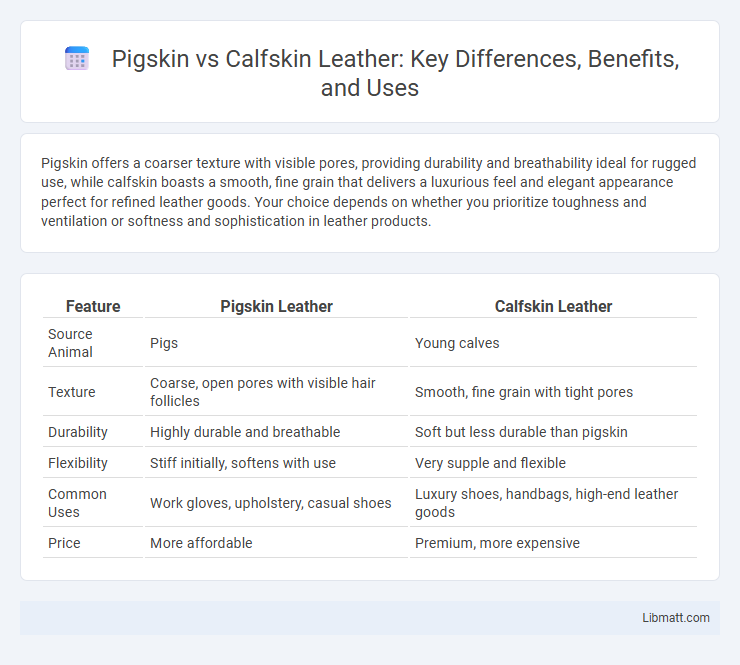Pigskin offers a coarser texture with visible pores, providing durability and breathability ideal for rugged use, while calfskin boasts a smooth, fine grain that delivers a luxurious feel and elegant appearance perfect for refined leather goods. Your choice depends on whether you prioritize toughness and ventilation or softness and sophistication in leather products.
Table of Comparison
| Feature | Pigskin Leather | Calfskin Leather |
|---|---|---|
| Source Animal | Pigs | Young calves |
| Texture | Coarse, open pores with visible hair follicles | Smooth, fine grain with tight pores |
| Durability | Highly durable and breathable | Soft but less durable than pigskin |
| Flexibility | Stiff initially, softens with use | Very supple and flexible |
| Common Uses | Work gloves, upholstery, casual shoes | Luxury shoes, handbags, high-end leather goods |
| Price | More affordable | Premium, more expensive |
Introduction to Pigskin and Calfskin
Pigskin is known for its durability and distinctive grain pattern, making it a popular choice for sturdy leather goods, especially sports equipment and rugged accessories. Calfskin, prized for its smooth texture and fine grain, offers a luxurious feel and is often used in high-end fashion items, gloves, and premium footwear. Your selection between pigskin and calfskin will depend on whether you prioritize toughness or refined elegance in your leather products.
Key Differences Between Pigskin and Calfskin
Pigskin leather features a more open grain structure with distinct pores, making it breathable and durable, whereas calfskin boasts a smooth, fine grain that offers a luxurious, supple texture. Pigskin is typically thicker and more water-resistant, ideal for rugged use, while calfskin is softer and more flexible, favored for high-end fashion accessories and footwear. Your choice between pigskin and calfskin depends on whether you prioritize toughness and breathability or refinement and softness.
Durability Comparison: Pigskin vs Calfskin
Pigskin leather is renowned for its durability due to its dense fiber structure and resistance to wear, making it ideal for heavy-use items like gloves and military gear. Calfskin, while softer and more supple, offers moderate durability with a smooth surface that resists abrasion better than many other leathers but is less rugged than pigskin. Both leathers provide excellent strength, yet pigskin outperforms calfskin in long-term durability for rough applications.
Texture and Appearance of Pigskin and Calfskin
Pigskin features a coarse, grainy texture with visible pores and natural imperfections, offering a rugged and durable appearance ideal for casual or sports footwear. Calfskin is smooth, soft, and fine-grained, providing a sleek, polished look commonly preferred for luxury shoes and formal wear. Your choice between pigskin and calfskin will impact the tactile feel and visual refinement of the leather product.
Comfort and Flexibility: Which Is Better?
Pigskin leather offers superior breathability due to its open pore structure, making it more comfortable for extended wear in warm conditions. Calfskin, known for its smooth texture and fine grain, provides greater flexibility and a softer feel, adapting well to your movements. For a balance of comfort and flexibility, calfskin is generally preferred, though pigskin excels in ventilation and durability.
Common Uses in Fashion and Accessories
Pigskin leather is commonly used for durable gloves, casual shoes, and rugged jackets due to its breathability and textured finish. Calfskin leather, prized for its smoothness and fine grain, is frequently utilized in luxury handbags, high-end footwear, and tailored jackets. Both materials offer distinct tactile qualities that influence their application in fashion and accessories.
Price Differences: Pigskin vs Calfskin
Pigskin leather is generally more affordable than calfskin due to its greater availability and coarser texture. Calfskin, prized for its smoothness and fine grain, commands higher prices reflecting its premium quality and durability. When deciding on leather products, consider your budget carefully, as calfskin offers a luxurious feel while pigskin provides a cost-effective alternative without compromising strength.
Environmental Impact and Sustainability
Pigskin leather generally has a lower environmental impact than calfskin because pig hides are often a byproduct of the pork industry, reducing waste. Calfskin requires more resource-intensive farming and longer animal lifespans, leading to higher greenhouse gas emissions and water use. Choosing pigskin supports your goal of sustainability by making use of materials that might otherwise be discarded.
Care and Maintenance Tips
Pigskin leather requires regular brushing and gentle cleaning to maintain its unique porous texture, while calfskin demands careful conditioning to preserve its smooth, supple surface. Avoid excessive moisture and direct sunlight for both types to prevent cracking and discoloration, and use specific leather care products tailored to their distinct grain patterns. Your routine maintenance ensures durability and keeps the softness and appearance of pigskin and calfskin leather goods intact.
Choosing the Right Leather for Your Needs
Pigskin leather offers exceptional breathability and durability, making it ideal for items requiring toughness and moisture resistance, such as work gloves and rugged footwear. Calfskin leather provides a smoother texture and superior softness, perfect for luxury accessories like high-end shoes and handbags that demand refined aesthetics and comfort. Selecting between pigskin and calfskin hinges on prioritizing either durability and breathability or elegance and softness to match your specific lifestyle needs.
Pigskin vs calfskin Infographic

 libmatt.com
libmatt.com